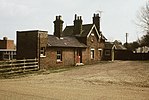Luton Hoo
Country house hotelsCountry houses in BedfordshireGardens by Capability BrownGolf clubs and courses in BedfordshireGrade I listed buildings in Bedfordshire ... and 7 more
Grade I listed housesHotels in BedfordshireListed buildings in LutonPrime ministerial homes in the United KingdomSecond Empire architectureUse British English from April 2019Vague or ambiguous time from January 2020

Luton Hoo is an English country house and estate near Luton in Bedfordshire and Harpenden in Hertfordshire. Most of the estate lies within the civil parish of Hyde, Bedfordshire. The Saxon word Hoo means the spur of a hill, and is more commonly associated with East Anglia.
Excerpt from the Wikipedia article Luton Hoo (License: CC BY-SA 3.0, Authors, Images).Luton Hoo
The Luton Drive,
Geographical coordinates (GPS) Address Website External links Nearby Places Show on map
Geographical coordinates (GPS)
| Latitude | Longitude |
|---|---|
| N 51.85463 ° | E -0.39764 ° |
Address
Luton Hoo
The Luton Drive
LU1 3TQ , Hyde
England, United Kingdom
Open on Google Maps




